|
|
|||
THIS WEEK at HILTON POND
22-30 September 2006
Installment #330---Visitor #
(Back to Preceding Week; on to Next Week)
|
WHEN IT'S DREARY AND COLD |
|
A GLORIOUS (BUT GORY)
GOLDENROD PATCH During our elementary school years in Pittsburgh PA, every Saturday morning a local radio station played a catchy little tune called the "Teddy Bears' Picnic." As young boys are wont to do, we re-wrote the song to make it more menacing--mainly to try scare all the girls in our third-grade class:
When we sang the revised version some girls did screech and kick us with their shiny patent leather shoes, but we doubt any of them were permanently scarred, or scared by bears. (We still, however, have tell-tale dents in our shins.) These days, as we walk along woodland trails, the old ditty sometimes comes to mind and we hum a few bars. Although we never fear being eaten by bears in the Piedmont woods, this week we couldn't help but think about how dangerous nature can be when we took a stroll alone through one of the most forboding Hilton Pond habitats of all--that deathtrap known as the Glorious (but Gory) Goldenrod Patch.
All text & photos © Hilton Pond Center From a distance, almost nothing in nature beats the sight a field of Goldenrod (above) basking in sunshine beneath a cloudless blue October sky. Up close, however, the Goldenrod patch becomes a scene of stealth and intrigue, where countless threats await unsuspecting visitors. The danger isn't to the human passerby, of course, but to the many bees and wasps and butterflies that visit Goldenrod flower heads, all intent on grabbing bites of pollen or a sip of nectar--and blissfully unaware their next meal may very well be their last. We've spent many pleasant hours in Goldenrod fields through the years, and we're always amazed at the incredible density of animal life that dwells within. On any warm autumn afternoon, clusters of Goldenrod blossoms are literally abuzz with pollinators--flitting industriously from one plant to another--while lurking upon those bright yellow flowers is as diverse a collection of predators as one could imagine. Ofttimes we have wondered how Goldenrod pollinators EVER manage to survive, considering practically every Goldenrod stalk harbors some predatory organism waiting--silently . . . secretly . . . patiently--for lunch to arrive.
This week in a small Goldenrod meadow at Hilton Pond Center the principal predators appeared to be spiders--lots of them and lots of different kinds. Our first encounter was with an aptly named Goldenrod Spider, Misumena vatia, sucking the life out of a Honeybee held fast by several of the spider's front legs. Goldenrod Spiders--also called "Crab Spiders" because of their crustacean-like shape, and/or Flower Spiders because that's where they're typically found--are about half-an-inch wide when fully grown, and perfectly capable of subduing a somewhat larger and heavier Honeybee. The spider--which occurs in either white or yellow forms--hides within the Goldenrod flower, motionless until a prey item flies in. At that point the spider lunges at the insect, pulling it near with its forelegs and quickly stabbing poisonous fangs through the prey's exoskeleton. Paralysis is almost immediate and the spider doesn't have to wait long before its toxic saliva serves its alternate role as a digestive enzyme that turns the insect's insides into nutrient-rich porridge. Ummm, ummm. Honeybee soup is good, good, good.
Just a few feet away was another arachnid that looked very different from the Crab Spider. Perched once again on a Goldenrod bloom, this spider had a three-quarter-inch lime-green body and extremely long spotted legs with long sharp spines (above). We immediately recognized this as a Green Lynx Spider, Peucetia viridans, which gets its common name from acting like a Bobcat or Lynx; i.e., hiding in vegetation and then leaping out suddenly to ambush unsuspecting prey. Although its bright green color wasn't much camouflage against the yellow flower blossoms, we might not have noticed this spider had it not been accompanied by a large, brown, irregularly shaped mass-- As we were taking what we thought were our final photos of this spider and her offspring-to-be, we heard and then saw a small Carpenter Bee buzzing around the spider's lair. It only took a few seconds for the bee to land on the flower, begin feeding and crawl just a wee bit too close to the spider, a swift-moving predator that wasted no time in demonstrating her cat-like prey-catching abilities. The bee never moved (above left), and now there's another batch of insect porridge for a spider to consume.
Not every denizen of the Goldenrod patch was as easy to photograph as first two spiders described above. In fact, we tried for almost an hour to get a good shot of a tiny, quarter-inch Jumping Spider that--true to its name--dipped and bobbed every time we got our 180mm macro lens within distance. Any attempt to herd the spider around with a blade of grass resulted in it taking what first looked like a suicide leap from the flower head. In each case, the spider anchored a strand of silk to the Goldenrod and stopped its fall about six inches or so from the jump spot. The best we could do on this little arachnid was to get a couple of exposures of it peering around a Goldenrod stem with one or more of its eight beady little eyes, but what else could we expect from such a homeless wanderer that builds no nest. Incidentally, the Jumping Spider's prey would be much smaller than a Honeybee or Carpenter Bee; we suspect little Hoverflies are a staple for this miniature eight-legger.
We don't want to give the impression spiders are the only dangers that lurk in the Hilton Pond Goldenrod plot. No, some of the threats walk on six legs rather than eight. What is undoubtedly the biggest predatory insect also happens to prey primarily upon insects, but it wouldn't turn down an equally predatory spider if one came its way. We're speaking here of the Carolina Mantid, Stagmomantis carolina (above), a native four-inch-long preying mantis that gets the job done with a technique different from that used by venomous spiders. Although the forelegs of the mantid in the photo above appear to have just two main segments, there are actually three; the first segment in prayerful fashion folds back against the second like a pocket knife. However, instead of having a sharp blade, the inner leg edges are lined with rows of thin, very sharp dagger-like projections. When a mantid goes after food, it unfolds the outer two foreleg segments, lashes out, grabs the insect or spider, and quickly dispatches it by rapidly refolding the leg segments and skewering the prey. The hapless spider or insect may struggle a little, but that doesn't stop the mantid from chowing down and eating its victim--dead or alive.
If the spiders in our Hilton Pond Goldenrod patch are like a fleet of sleek and speedy new Lexus automobiles, then the last predator we came across was more like a slow-moving vintage Volkswagen Bug. In fact it really was a BEETLE--specifically a Seven-Spot Ladybird Beetle, Coccinella septempunctata, AKA a "Ladybug." Ladybird Beetles--of which there are about 6,000 species world-wide--are all predaceous, dining in both adult and larval stages on almost-microscopic creatures such as spider mites, mealybugs, and scale insects. The first Ladybird Beetle we found was patrolling an unopened Goldenrod flower cluster (above), probing with its antennae and occasionally finding and biting down on tiny green aphids--a small but nutritious source of fats and proteins. The aphids themselves were bulging with plant sap, so undoubtedly they likewise provided the Ladybird Beetle with its minimum daily requirement of plant carbohydrates. During the 1970s, millions of quarter-inch-long C. septempunctata were brought from Europe to New Jersey to control aphids on row crops and ornamental plants; as often happens, these slow-moving fast-mating aliens became invasive and spread throughout the eastern U.S., probably displacing smaller and less-aggressive native ladybug species. Adult Seven-Spot Ladybird Beetles overwinter in protected places--including the warm interiors of human dwellings where they can congregate by the hundreds or thousands, much to the chagrin of homeowners.
Bottom Line: When we go down to the woods today, we aren't afraid to go alone, for we KNOW we won't be eaten by any bears--growling grizzlies, picnicking teddies, or otherwise. However, as we stroll in autumn through our small meadow at Hilton Pond Center, we're ever alert for all the predators it hides, and we're very, very glad we're not potential prey in the Glorious (but Gory) Goldenrod Patch.
All text & photos © Hilton Pond Center
Comments or questions about this week's installment?
Thanks to the following fine folks for recent gifts in support of Hilton Pond Center for Piedmont Natural History and/or Operation RubyThroat: The Hummingbird Project. Your contributions allow us to continue writing, photographing, and sharing "This Week at Hilton Pond." (See Support if you'd like to make a gift of your own.)
"This Week at Hilton Pond" is written & photographed You may wish to consult our Index of all nature topics covered since February 2000. You can also use our on-line Hilton Pond Search Engine at the bottom of this page. For a free, non-fattening, on-line subscription to |

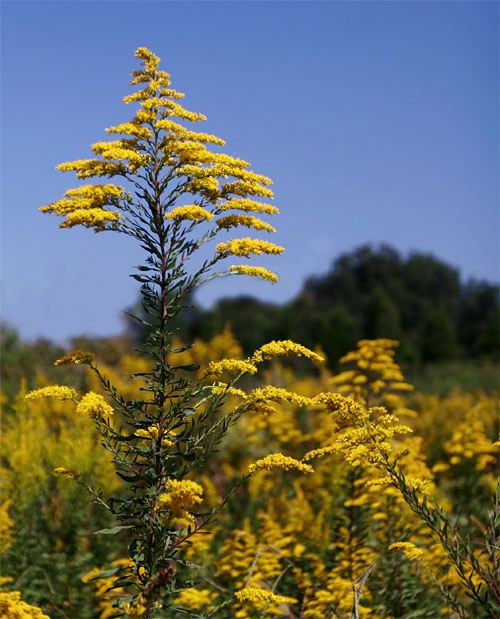
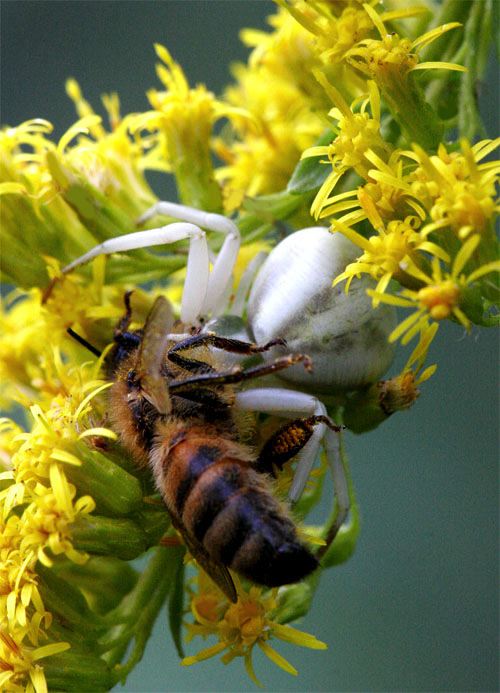
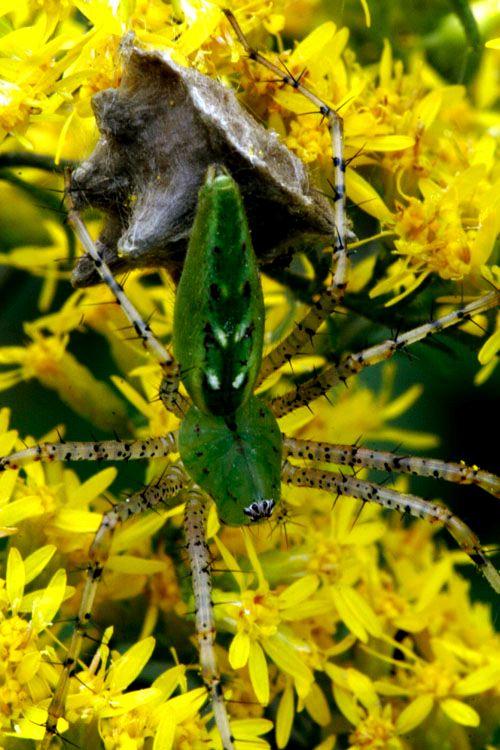
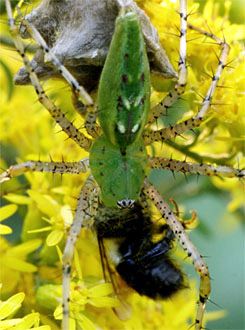 an egg case that could contain as many as 500 eggs. Female Green Lynx Spiders are known to fearlessly guard their unhatched progeny, feinting at much-larger intruders and even spitting venom from their fangs.
an egg case that could contain as many as 500 eggs. Female Green Lynx Spiders are known to fearlessly guard their unhatched progeny, feinting at much-larger intruders and even spitting venom from their fangs.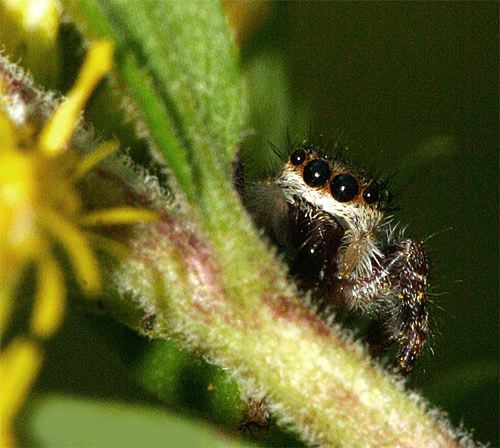

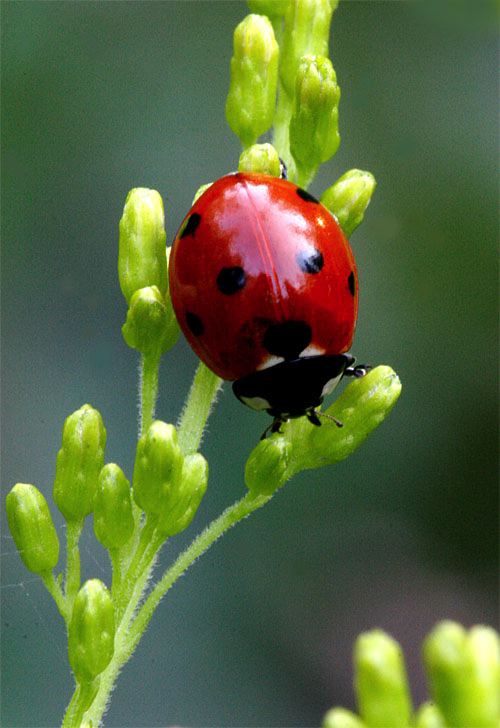
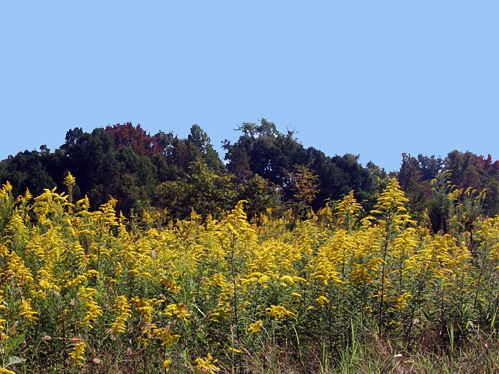
 POSTCSRIPT: We heard from several readers who also remember "Teddy Bears' Picnic" from the 1950s. Turns out the radio show first was called "Big Jon and Sparkie" and changed to "No School Today" before it was syndicated nationally. The theme song was performed by little Ann Stephens and, incredibly enough, is available on Amazon (album cover at left). To bring back a flood of memories for all those who requested them, here are the actual lyrics:
POSTCSRIPT: We heard from several readers who also remember "Teddy Bears' Picnic" from the 1950s. Turns out the radio show first was called "Big Jon and Sparkie" and changed to "No School Today" before it was syndicated nationally. The theme song was performed by little Ann Stephens and, incredibly enough, is available on Amazon (album cover at left). To bring back a flood of memories for all those who requested them, here are the actual lyrics:

 Please report your
Please report your
